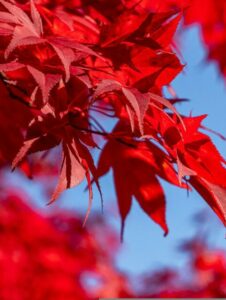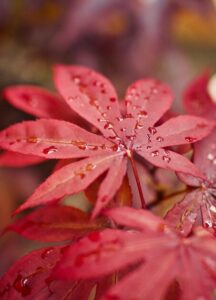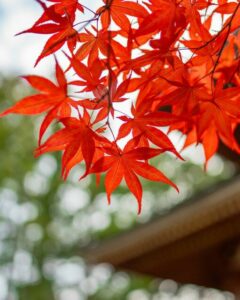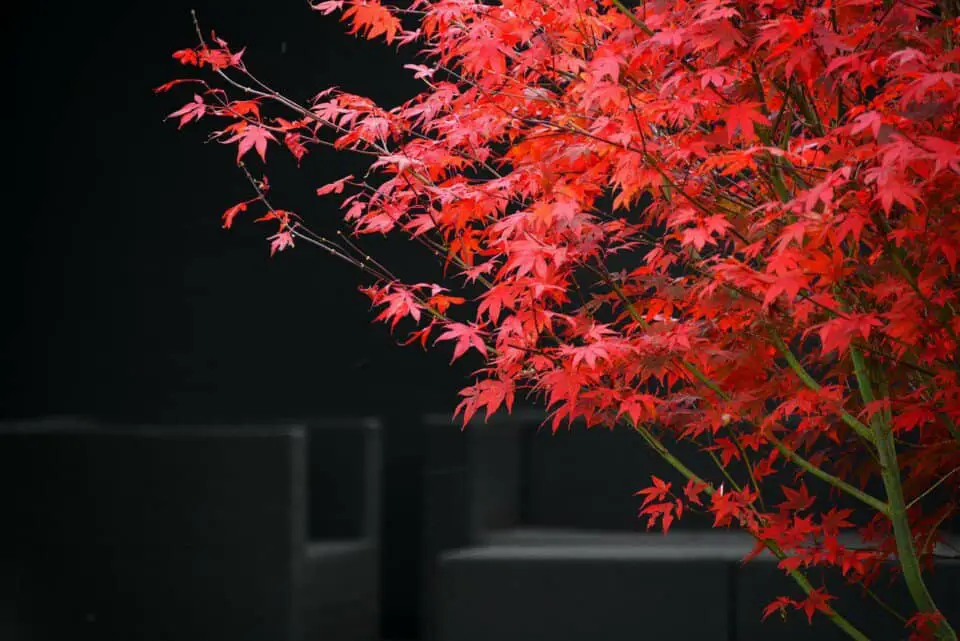Some links in the post are affiliate links and I get a commission from purchases made through some links found in the post.
The red maple, also known as the swamp or scarlet maple, is a deciduous tree that grows up to 70 feet (21 meters) tall outdoors.
When it has access to the proper nutrients, it can be as wide as 50 feet (15 meters) and gives rise to red, orange, or yellow leaves in the fall.
This highly adaptable tree also flowers in the spring, giving rise to red flowers that add to its allure. And in the winter, its stems take on a beautiful red hue. Anyone who wants a sight to behold throughout the year would be right to pick this tree.
Does it get any better than this? Sure! Most gardeners often fret about the kind of fertilizer they should use and when. But with the red maple, you can go years without ever needing to amend its soil.
The red maple rarely needs fertilizer, and, in most cases, a combination of mulch and compost will work the magic.
However, you may need to add some feed occasionally. If fertilizing use a NPK feed of 10-4-6, or 16-4-8.
I will break down when your red maple needs fertilizer, the options available to you, and how to cap your fertilizing to avoid harming the plant:
When Should I Fertilize My Red Maple?
The red maple is one of the sturdiest maple trees you will come across. And many people have successfully cultivated it without using commercial feeds.
However, this is not always the case, and some situations may arise where you need to step in and help your tree. Which are these circumstances?
1) When the Red Maple is Young
We all want to give our trees the best chances of survival. And we know that when trees are young, they are not established enough to fend for themselves.
That’s when they need us to be on our toes, catering to their needs. You can always feed your red maple in its earlier years to allow it to establish devoid of nutritional deficiencies – much like a baby if you think about it.
2) When the Plant Starts Yellowing in the Spring and Summer
Some red maples give rise to yellow leaves. However, this happens in the fall but not in the active growing months.
Sometimes, the yellowing can point to issues such as overwatering and underwatering. But if none of these suffice, you may want to consider that your red maple needs more fertilizer.
3) When the Tree Does not Grow
If your red maple has already established and has access to water and light, it should grow well and fast. At the very least, it should have some inches of growth each year. But if this is not happening, it may need a boost.
4) When the Size of Leaves Seems to be Diminishing
 Mature leaves on the red maple take on a relatively similar size. Thus, if the new leaves seem smaller, you should have a reason for concern.
Mature leaves on the red maple take on a relatively similar size. Thus, if the new leaves seem smaller, you should have a reason for concern.
It shows that the roots are not absorbing enough nutrients to support the growth of healthy leaves. Often, it boils down to a lack of nitrogen.
Suppose you’ve resonated with any of the reasons above. When should you fertilize your red maple? The first step would be to test the soil nutrients in the soil.
Sometimes, you may think that your plant needs more nutrients, yet it has access to everything it needs.
Once you have established that there indeed is a nutritional deficit, you can move on to fertilizing your red maple in the spring.
Spring is an active growing month that will allow the tree to take up the nutrients and use them, leaving minimal residue by the time winter comes around.
You may also like: 6 reasons your acer tree is dying & how to fix it
What Type of Fertilizer Should You Give Your Red Maple?
When feeding your red maple, you should consider how each nutrient affects your tree. That helps you gauge how much of each nutrient you should include in the feed. The key considerations are:
Nitrogen (N)
Your maple tree cannot grow without nitrogen. After all, it needs it to make chlorophyll and thus make enough food to support its growth.
Nitrogen also enables the plant to produce dark and healthy leaves. You can tell that your red maple needs more nitrogen if its leaves have started yellowing or reducing in size.
Phosphorus (P)
Another vital nutrient for the red maple is phosphorus which aids in energy transfer and food production.
Thanks to its importance, you can find it in almost every plant cell. It also plays a crucial role in the reproductive processes in the red maple.
Your red maple can suffer stunted growth or darkening of its leaves in the absence of this nutrient.
Potassium (K)
When your red maple has access to enough potassium, its water and nutrient movement processes suffer a boost.
Thus, it hedges the risk of dehydration and boosts the development of healthy roots.
Where proper nutrient movement does not occur, your plant shows signs of burning on the tips of the leaves, yellowing between the veins, and brown spots on the leaf edges.
Of all these nutrients, nitrogen is the most important, with the others serving supporting roles. Your tree still needs access to other macronutrients and micronutrients, but it can get these in the soil.
These are also available as extras in commercial feeds. As such, when getting a fertilizer, focus on the NPK formulas with ratios of:
- 10-4-6, or
- 16-4-8.
In the above cases, you can see that nitrogen (N) is the most abundant nutrient, with potassium coming in second and phosphorus taking a back seat. The ratios depict the concentration of each nutrient in percentages.
Also, you must think of how available the nutrients will be to the red maple. As I said, it can do well without fertilizer. If anything, using too much fertilizer can damage the plant’s roots and kill it.
So, it’s always best to choose a slow-release fertilizer instead of a quick-release fertilizer. The former option will seep into the soil gradually, allowing the tree to take in what it needs at its preferred pace.
The latter will flood the soil with nutrients, leading to fertilizer burn.
When deciding on the form of fertilizer to use, you can choose between any of the following formulations:
- Granular Options,
- Liquid Fertilizers, and
- Fertilizer Spikes.
Organic inputs can also provide your tree with nutritional boosts. Consider using manure, compost, and mulch for trees that do not need immediate amending.
As these break down, they release macronutrients into the soil and help the red maple establish more vigorous roots.
How Much Fertilizer Should You Give Your Red Maple?
Overfertilization can kill your plant, and you should avoid it as much as you can. Your red maple is better off with no fertilizer than more than it can handle. Follow the tips below to avoid going overboard:
a) Granular Fertilizers
 These feature a broadcasting application method, and it’s easy to get carried away with how easy they are to use. As such, you should follow the instructions given by the manufacturer.
These feature a broadcasting application method, and it’s easy to get carried away with how easy they are to use. As such, you should follow the instructions given by the manufacturer.
Understand how much of the feed you can use, then incorporate it into the soil near your maple. You should not use the feed directly on the base of the plant.
Instead, you should measure about a foot from the base, then start dispersing the feed or digging it into the soil.
When should you use this feed? – Early spring. You can also use it in the late fall after the tree has lost its leaves.
b) Liquid Fertilizers
Due to their easy uptake, you can use these fertilizers once a month during the spring and summer months. Ensure you get a slow-release fertilizer and abide by the manufacturer’s instructions.
You will need to dissolve the pellets in water and use this solution to water your plant. Then avoid watering your plant for the next few days to avoid washing away the feed. You can then continue watering your tree as usual.
c) Fertilizer Spikes
If you are new to using commercial feeds, these might be the easiest options. You will need to follow the manufacturer’s instructions when deciding how many spikes you should use for your tree.
Most importantly, you must drive the spikes into the ground at regular intervals. That encourages even growth and allows your tree to thrive.
Commercial feeds feature different strengths, so it’s always best to adhere to what the manufacturer recommends. If your soil does not need much amending, you can dilute the fertilizer to half its strength.
Our 3 Recommended Fertilizers for A Red Maple
Many commercial feeds can work for red maples. All you need to look for are feeds that can boost the growth of trees.
Those suited for maple trees are better for red maples as they can hone in on what your tree needs. Our best picks are:
1) TreeHelp Premium Fertilizer for Maple
This slow-release fertilizer comes in granular form and is suitable for promoting healthy root development in your red maple.
Its inclusion of natural matter is ideal for promoting the tree’s defenses against pests and diseases.
2) BioAdvanced 701810A Systemic Plant Fertilizer and Insecticide
This fertilizer has pest protection capabilities, enabling your red maple to ward off infestations for a year.
Moreover, it feeds the soil, making it more suitable for the red maple.
3) Jobe’s 01660 Fertilizer Tree & Shrubs
This time-release fertilizer targets nourishment at the roots, reducing wastage and encouraging continuous nourishment. Inserting the spikes is relatively easy.
Just push them inside the ground in the spring, and they will feed the tree all season.
Remember to adhere to the manufacturer’s instructions.
How To Make a Homemade Fertilizer for Your Red Maple
There are various feeds you can make from the comfort of your home, including eggshells, banana peels, etc. So, how about combining them in one? Here’s what you do:
- Combine green and brown materials: Green materials are fresh, like grass trimmings and kitchen waste. Brown ones include wood shavings, paper, and fallen leaves. Ideally, you should include three parts of brown matter and one of green materials. That increases the aeration of the compost and reduces the smell.
- Wet the materials often but don’t leave them soggy. Access to too much water paves the way for rotting instead of decomposing. Add just enough water to dampen the pile without soaking it.
- Stir the materials twice a month and give it two months to cook.
You will know the compost is ready when it no longer feels warm to the touch, signaling that the decomposition has now ended. You can then use it in the soil around the tree at the start of spring.
You may also like: What are the common red maple problems & how to fix them
Is Epsom Salt Good for Red Maple Trees?
Epsom salt comprises magnesium and sulfur, micronutrients essential to its growth. Thus, adding it to the soil would be a welcome idea.
However, magnesium increases the uptake of nitrogen and phosphorus. If the soil already has commercial NPK feeds, this will create a fast-release scenario, increasing the tree’s access to this nutrient.
And this can hinder the uptake of other nutrients. It is thus better to use this compound when you have not used other commercial feeds in the soil.
Are Coffee Grounds Good for Red Maples?
Red maples grow well in slightly acidic soils with a pH range between 4.5 to 6.5. Coffee grounds have a pH within this range and would thus be suitable for your tree.
They also improve the texture of the soil. Use a pound of coffee grounds for every foot of the tree each season, and it should be good.
However, you should first check if the tree has access to nitrogen. Coffee grounds increase the nitrogen levels and could harm the tree if they are more than necessary.
You may also like: Japanese maple vs red maple
When Should You Not Fertilize Your Red Maple?
While nutrient boosts are good for your tree, please note the circumstances under which you should not feed the maple tree:
- In the winter: At this point, the tree will have shed its leaves and will thus not be making food. As such, any nutrients you add to the soil will not have much of an effect on its growth. Such addition can even damage the tree’s roots.
- When it shows signs of overfeeding: Like the red maple can signal underfeeding, it can also show signs of distress relating to too many nutrients. These include yellowing and browning of the leaves. In this case, it is best to flush the soil and give the tree time to recover.
- When you have already fed the tree: Unless you are using a monthly liquid fertilizer, you should only feed the red maple once a year. Any more than this would result in overfeeding.
Additionally, you should not feed the tree if a soil test reveals it has adequate access to macro and micronutrients. You would only alter the existing balance and hurt its chances of developing healthy roots and leaves. You could even kill it.
Final Thoughts
 Growing a healthy red maple tree is not an uphill task. This tree originates from deciduous forests, where it sources nutrition from dead leaves.
Growing a healthy red maple tree is not an uphill task. This tree originates from deciduous forests, where it sources nutrition from dead leaves.
As such, it will rarely need extra feeding. But when it does, please follow the recommendations above to avoid overfeeding it.
Happy Gardening!
Before you go, here are some more related articles I encourage you to read below to help solve more of your gardening issues:




